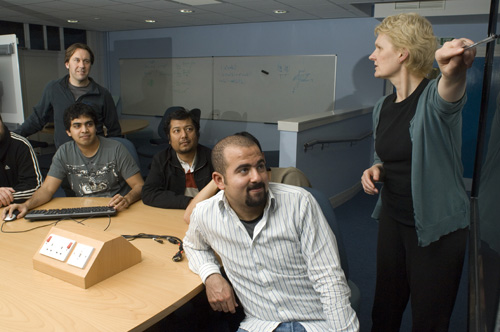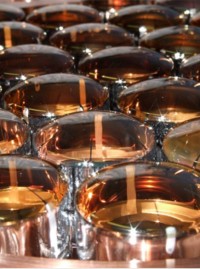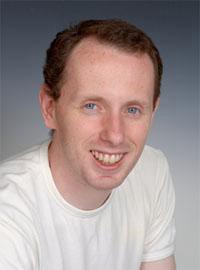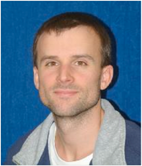
The International LOFAR Telescope - a network of radio telescopes across Europe - has taken its first ‘pictures’, revealing a black hole in a distant galaxy in greater detail than ever before. The image of the black hole, called quasar 3C196, also demonstrates the huge field of view that LOFAR captures in a single image: an area of sky equivalent to a thousand full moons.
LOFAR’s network of radio telescopes is designed to study the sky at unprecedented resolution, using the lowest radio frequencies accessible from the surface of the Earth. The UK LOFAR station, located at STFC's Chilbolton Observatory, is the western-most telescope in the network, and its addition creates a total array almost 1000 km wide, making LOFAR the largest telescope in the world. The addition of Chilbolton also makes LOFAR's images three times sharper.
Dr Philip Best, a Reader at the University’s Institute for Astronomy, is Deputy LOFAR-UK leader. He said: “LOFAR allows us to see smaller and fainter objects in the sky, which will help us to answer fundamental questions about cosmology and astrophysics, such as when did the first galaxies form. Here in Edinburgh we are very excited about using LOFAR to study galaxies and quasars in the early Universe."
The new image was created by combining signals from LOFAR radio telescopes in the Netherlands, France, Germany and the UK, using the LOFAR BlueGene/P supercomputer in the Netherlands. The connection between the Chilbolton
telescope and the supercomputer requires an internet speed of 10 gigabits per second – over 1000 faster than the typical home broadband speeds.
Professor Rob Fender, LOFAR-UK Leader from the University of Southampton, said "Getting that connection working without a hitch was a great feat requiring close collaboration between STFC, industry, universities around the country and our international colleagues.”
LOFAR was designed and built by ASTRON in the Netherlands and is currently being extended across Europe. As well as deep cosmology, LOFAR will be used to monitor the Sun’s activity, study planets, and understand more about lightning and geomagnetic storms. LOFAR will also contribute to UK and European preparations for the planned global next generation radio telescope, the Square Kilometre Array (SKA).
Further information
LOFAR
LOFAR will focus on six areas of research:
- 1.The Epoch of Reionisation - understanding how the first stars and black holes made the universe hot.
- 2.Extragalactic surveys - what is the history of star formation and black hole growth over cosmological time?
- 3.Transients and Pulsars - probing the extreme astrophysical environments that lead to transient bright bursts in the radio sky.
- 4.Cosmic rays - what is the origin of the most energetic particles in the universe?
- 5.Solar and space environment - mapping the structure of the solar wind, how it relates to solar bursts, and how it interacts with the Earth.
- 6.Cosmic Magnetism - what is the origin of the large-scale magnetic fields that pervade the universe?
LOFAR-UK
The LOFAR station in the UK is the first major new radio telescope to be built in Britain for many decades and was opened by Professor Jocelyn Bell-Burnell on the 20th September 2010. Like all the other stations, it is linked back to a central supercomputing facility at Groningen in the Netherlands using a high-speed network connection, the equivalent of 5000 standard domestic broadband connections combined into one.
LOFAR-UK is funded through a collaboration of UK universities with the SEPnet consortium and the UK Science and Technologies Facilities Council which includes RAL Space at STFC's Rutherford Appleton Laboratory, STFC's UK Astronomy Technology Centre and STFC's Chilbolton Observatory.The LOFAR-UK consortium represents 22 British universities, making it the largest radio astronomy consortium in the country.
The quasar galaxy 3C 196
3C 196 is a quasar (compact radio source) in a galaxy so far away that light from it has travelled for almost half the age of the universe to reach us (at a redshift of z=0.871). The word “quasar” means “quasi-stellar object”. Quasars look like single stars in visible light because the light coming from close to the central black hole is so bright that it outshines all the stars in the galaxy in which it is embedded. The quasar 3C 196 was picked for the first light image of the LOFAR Telescope to show the massive increase in image sharpness (resolution) when the international stations are added to LOFAR.
Image gallery

School Acoustic Group collaborates on art installation at Informatics Forum.
Working with Glasgow artist Marianne Greated, the School of Physics and Astronomy has constructed an installation in the Inspace exhibition room in Edinburgh.
The work relates to the theme of anthropogenic sound in our environment, and comprises a hemi-anechoic chamber containing a 10 metre panorama with soundscape in 5.1 surround sound. It is part of the public engagement
programme 'Sound in a Man-Made Environment', which is run by researchers at the University of Edinburgh in partnership with the National Physical Laboratory, and funded at the University by the Engineering and Physical Sciences Research Council.
"The paintings in the panorama depict our urban landscape and the soundscapes have evolved from recordings of those same environments, mainly sourced in and around Glasgow. Levels of anthropogenic sound in our environment have increased significantly in recent years and have an important impact on our everyday lives." Marianne Greated
From January-March 2011 the thematic for Inspace is Non-Bio Boom and this period will feature exhibits and functions relating to the theme of anthropogenic sound.

Meet the people behind our MSc in High Performance Computing, which trains the next generation of computational science professionals.
The University’s first Postgraduate Virtual Open Week will take place from the 21st to the 25th of February. If you are interested in applying for the MSc in High Performance Computing at the School of Physics & Astronomy, this is a good opportunity to:
- Talk to staff from the MSc in HPC
- Discuss career opportunities and financial support
- Meet current students
Live sessions in the chat rooms and virtual space will allow you to talk to staff and current students about applying for the MSc, studying in the University, living in Edinburgh... and any other aspect of studying with us.
Registration
Registering now allows us to keep you informed about what’s happening, give you any technical help you may need, and make sure you have a chance to participate in the Open Week's events. See the link below.


Dr Alex Murphy, a Reader in the School's Nuclear Physics group, will be delivering a lecture on Dark Matter and Dark Energy as part of the University of Bath's Millennium Lectures series. The series forms part of the programme of the International Year of Chemistry.
- Venue Bath University
- Date February 9th 2011
- Summary 'The materials of the everyday world around us are composed of the chemical elements, in turn formed from atoms and their substructures. Yet when we examine the motions of stars and galaxies we are led to the remarkable conclusion that the energy content of the Universe as a whole is completely dominated by fundamentally different materials, dubbed "dark matter" and "dark energy". What is the evidence for this remarkable statement? What are these new entities? And can we prove they really do exist? Find out how an experiment deep in a potash mine near Whitby might be about to provide some of the answers.'
You can read more about the work in the Boulby potash mine in this article in the Mail On Sunday.
The 3 simulations in the gallery below were produced by the Millennium Project, with each showing slices of Dark Matter distribution. The slices through the density field are all 15 Mpc/h thick. Three panels are shown for each redshift: subsequent panels zoom in by a factor of four with respect to the previous ones.
Image gallery

A new 1-year foundation level course makes the School’s degree courses accessible to students whose qualifications have previously not been recognised by the University of Edinburgh.
The Integrated Foundation Programme will provide an entry point for many of the full degree programmes available in the College of Science and Engineering. This innovative programme will be integrated with the College’s first year of undergraduate study and so - unlike many other foundation programmes - does not mean an extra year of study.
Students will choose two subjects from among mathematics, physics, chemistry, biology and engineering. An ‘English for academic purposes’ course – tailored for Science and Engineering students – will also be available.
After successful completion of the Programme, students will enter the second year of study alongside Degree students who have taken the standard first year.
"The Integrated Foundation Year is a new and most welcome access route for the best international students from a range of countries. We look forward to welcoming this new group to the University and the city."
Dr Will Hossack, Director of Teaching
Application to the Integrated Foundation Programme will be through the UCAS system.
To register an interest in applying for the Integrated Foundation Programme, please email foundation [at] ed.ac.uk with the following information about yourself:
• full name
• country of residence and nationality
• preferred area of study
• school or other qualifications held or being taken

Professor Richard Kenway has been appointed Chair of the PRACE Scientific Steering Committee (SSC).
PRACE is building a Europe-wide research infrastructure that will use the region’s most advanced computing technologies to support scientific breakthroughs across all disciplines. The Scientific Steering Committee advises the PRACE enterprise on all scientific and technical matters, with particular responsibility for overseeing the peer review process for the allocation of PRACE resources.
"We need to adopt a cross-disciplinary approach in which computer scientists, mathematicians and applications specialists work together."
Professor Kenway said: “The pursuit of scientific excellence above all else will be key to our success, both to justify continued investment by the PRACE partners and to ensure Europe remains competitive in exploiting strategically vital HPC technologies. We need to adopt a cross-disciplinary approach in which computer scientists, mathematicians and applications specialists work together. I foresee the gaps between disciplines closing as we tackle the big problems of science, and the exploitation of HPC technologies will be in the vanguard of this multi-disciplinary research.”
Professor Kenway is Head of the School of Physics & Astronomy, Tait Professor of Mathematical Physics at the University of Edinburgh and Chairman of EPCC.

Dr Peter Boyle of the particle physics theory research group in the Institute for Particle and Nuclear Physics has worked with Columbia University and IBM's BlueGene team to design part of IBM's prize winning next-generation supercomputer processor.
An academic team from the Institute for Particle and Nuclear Physics in the University of Edinburgh and from the Physics Department at Columbia University has collaborated with IBM (NYSE:IBM) over the last three years on the chip design of IBM's next generation BlueGene prototype computer in a unique industrial-academic collaboration.
This prototype has been judged the world's most energy efficient supercomputer taking first place on the Supercomputing 'Green500 List' for November 2010.
Both University of Edinburgh and Columbia University plan to use the system to advance quantum chromodynamics (QCD) simulations in their research of particle physics. The Edinburgh system is funded by the UK Science and Technology Facilities Council and will be installed the the Advanced Computing Facility at the University of Edinburgh. The Columbia University design effort was carried out in partnership with the RIKEN BNL Research Center which, together with the Brookhaven National Laboratory (BNL), will fund a system to be installed at BNL.

Dr Peder Norberg of the Institute for Astronomy (IfA) is among the Royal Society's 30 new University Research Fellows (URFs) for 2010. He has also been awarded a European Research Council Starting Grant (ERC StG).
The combined value of the awards is around €1.8million over approximately five years. Both awards are intended to support outstanding early-career researchers and enable them to carry out their pioneering ideas.
Peder's research aims to critically test the successful Cold Dark Matter model, and improve our knowledge of galaxy formation and Dark Energy. The ERC citation noted the IfA's strong record of research in this area.
Peder said: 'The combination of these awards presents a unique opportunity to establish myself as a true leader in my field and build a full research team to critically test the most successful cosmological model to date - the standard Cold Dark Matter model – and to provide key insights into the formation of galaxies over time. This frontier research utilizes the most recent galaxy surveys, including the Galaxy And Mass Assembly survey, of which I am Co-Project Leader, and the proprietary Pan-STARRS PS1 survey.'
Peder’s ERC Starting Grant is one of five awarded to the University this year and there are now three ERC grant holders at the IfA, making it unusually successful among astronomy institutes in this respect.
Below, Peder explains the background to his work.
ERC Starting Grants
ERC Starting Grants are prestigious awards which allow researchers in any subject (save nuclear research) who finished their PhD 2-12 years ago to undertake cutting-edge research at any European research institution. Awards last for up to 5 years and provide significant funding – up to EUR 1.5 million – to support the investigator and team. While the scheme is competitive, more cash is being invested in it each year by the European Commission.
Anyone in the School who would like to apply for ERC funding should first contact David Dougal at ERI: David.Dougal [at] ed.ac.uk Tel: 0131 650 9025
A universe filled with undetected cold dark matter and mysterious dark energy
Dr Peder Norberg
Galaxies are not distributed uniformly: they tend to clump together in groups and clusters. Our grasp of this distribution was revolutionised by the "Sloan Digital Sky Survey" (SDSS) and the "2dF Galaxy Redshift Survey", which mapped out the distances of millions of bright galaxies by measuring their redshift.
This key information on how galaxies are distributed in space contributed directly towards a standard model that describes the observed Universe, composed of three parts: ~5% ordinary matter; ~20% Cold Dark Matter (CDM), a theoretically motivated materia, yet to be directly detected; ~75% Dark Energy, a hypothetical form of energy filling the entire Universe. Hence we are faced with a real enigma as 95% of the content of the Universe is unknown to mankind. This drives my quest to further test the validity of the successful CDM model and to better understand what Dark Energy is.
Gama: a multi-wavelength and spectroscopic survey to test a key model prediction
The properties of CDM are accurately predicted via computer models. Dark Matter tends to cluster, forming large clumps (halos) connected by filaments, creating a so-called cosmic web. This is very similar to the observed distribution of galaxies. In this structure formation model, CDM becomes hence the natural skeleton on which galaxies form and evolve. The main problem is the lack of a distinct proof of its existence, including its non-detection in underground experiments.
I am a co-leader of the "Galaxy And Mass Assembly" (GAMA) redshift survey. GAMA will measure 400,000 new galaxy redshifts and provide a complete account of all galaxy positions in the nearby Universe. It is designed to provide a constraint to a key CDM model prediction, as given by the number of Dark Matter halos per unit volume as function of their mass. Our estimate will rely on counting the number of galaxy groups in GAMA and measuring their masses. Such analyses require the use of many state-of-the-art mock Universes, created from large CDM simulations populated with galaxies following either some galaxy formation recipe or some statistical framework calibrated on real GAMA data.
Pan-STARRS: a unique imaging survey to probe the properties of Dark Energy
Dark Energy, unlike CDM, is theoretically poorly understood and observationally its properties are barely constrained. This led to the construction of several gigantic galaxy surveys, including Pan-STARRS, with main cosmological aim to determine whether Dark Energy changes with time. To help answer that crucial question, my goal is to study the galaxy distribution in Pan-STARRS and quantify its degree of clumpiness at times when the Universe was just half its current age.
Unlike GAMA, Pan-STARRS is an imaging survey with approximate estimates of galaxy distances. Those photometric distances rely on observations at different wavelengths and extra input, like the composition of galaxies and stellar evolution. Their uncertainty and the planned survey sizes are such that new dedicated clustering techniques have to be developed to best extract the underlying signal. Within Pan-STARRS, I lead the group that considers these new statistics, with which we aim to characterise the relation between the observed galaxy light and the underlying mass over time. This work is a vital step towards measuring the evolution of Dark Energy.

The School of Physics and Astronomy has been awarded “Juno Practitioner” status by the Institute of Physics.
Project Juno recognises and rewards Physics departments and schools that address the under-representation of women in university Physics. It also encourages better working practices for both women and men. The “Juno Practitioner” award recognises the excellent work done by the School to apply the Juno programme’s principles.
Cait MacPhee, the School of Physics and Astronomy’s Juno Champion, said: “We are delighted that the IoP has awarded us Juno Practitioner status and we are eager to move forward to become Juno Champions.
“Our submission highlighted some areas of which we can be very proud, including increasing equality of representation in academic staff, and our higher-than-the-national-average proportions of women at undergraduate and postgraduate levels. We will focus now on career development for all staff and students, to ensure equality of opportunity for men and women at all stages of their career.”
The Scottish Universities Physics Alliance (SUPA) has given high priority to Project Juno, with all its partner institutions signing up to the Juno principles. Edinburgh and Glasgow universities have both now successfully achieved “Practitioner” status.
The five Juno principles are:
1) a robust organisational framework to deliver equality of opportunity and reward;
2) an appointment and selection processes and procedures that encourage men and women to apply for academic posts at all levels;
3) departmental structures and systems which support and encourage the career progression and promotion of all staff and enable men and women to progress and continue in their careers;
4) departmental organisation, structure, management arrangements and culture that are open, inclusive and transparent and encourage the participation of all staff;
5) flexible approaches and provisions that enable individuals, at all career and life stages, to optimise their contribution to their department, institution and to SET (science, engineering, technology and the built environment).
This talk explores major aspects of the life and work of Charles Piazzi Smyth: one of the best-known and most fascinating scientists in Victorian Edinburgh.
This talk explores major aspects of his life and work, focusing especially on Smyth's fascination with Egypt and Egyptology, a major fashion of nineteenth century Scottish culture and a vital element both in the arts and sciences of the period. Smyth's passion for Egypt, which brought him into violent conflict with the Royal Society of London and many other organisations, reveals much of what drove the sciences in the nineteenth century and the way they advanced.
The talk will feature some of Piazzi Smyth's original artefacts from the Museum's collections. There will also be a chance to see the Museum's slice-of-life character of Piazzi Smyth's (fictional) 2nd assistant.
This event is part of the UNDERSTANDING TECHNOLOGY series of public lectures, which presents leading international research and ideas in the history, philosophy, politics and sociology of technology.
Date:
Thursday, 11 November 2010
Time:
6pm
Venue
Early People Gallery, National Museums Scotland
Registration
Please register with Maureen Kerr on 0131 247 4274 or m.kerr [at] nms.ac.uk
Admission
Free and open to all
Speaker:
Professor Simon Schaffer
Affiliation:
University of Cambridge University
Event Type:
General Event

